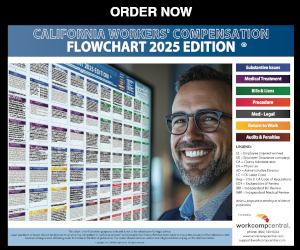Today is
Wednesday, July 16, 2025 -
Industry Insights
December 31, 1969
Requesting Change of Physicians - Part 1
- State: California
- - Popular with: Medical
- - 1 share
California Labor Code section 4600 and Regulation section 9786 permit a defendant to petition for a request to change the treating physician. While not something that is requested on a routine basis, there are legitimate, compelling reasons to seek this remedy at times. We'll explore a request for change of treating physician in two parts.
Why is filing a petition a good business decision? There are several reasons why it is appropriate to seek this remedy. First, filing a petition is your legal remedy to enforce appropriate medical treatment and reporting. Since controlling medical is essential to cost containment, one of the necessary duties of the claims examiner is to ensure that the treating physician is acting properly within the guidelines of the Labor Code and Regulations. If the treating physician either fails or refuses to comply, then a petition seeking a change is one of just a few remedies.
Further, the physician's lack of compliance with reporting requirements impacts benefit timeliness, and may cause either over payment of benefits, missed benefits, or inappropriate benefits decisions, all of which could result in penalty situations. Inadequate treatment and/or lack of reports can also increase the life span of the file. Finally, though this will not be true for post '03 injuries, the Primary Treating Physician (PTP) opinion carries the presumption of correctness and impacts the final outcome of the file. If you are uncomfortable with the reputation or reporting of the PTP, filing a petition is one of your remedies.
Now the downside, few Petitions for Request for Change of Physician are successful. Overwhelmingly, the rejection is due to technical errors on the part of the requesting party. Research the case, document the file, and set forth the fact clearly in your Petition.
The Administrative Director rejects 85% of justified Petitions because they have been incorrectly filed or do not contain the appropriate supporting documentation. Justified, carefully organized and prepared Petitions will be approved, but you must pick and chose your battles carefully. The Petition must provide specifics, including dates and justification.
First, examine the most frequently encountered grounds for filing a Petition: 1) the PTP has not complied with the reporting requirements contained in CCR 9785; 2) the PTP is not in a reasonable geographic area; 3) treatment is inappropriate and the employer/carrier is willing to offer more effective treatment; 4) the current treatment plan is not consistent with the treatment plan submitted pursuant to CCR 9785; 5) the PTP is unlicensed; or 6) the PTP has a conflict of interest (example: injured worker is an immediate family member).
In addition, be mindful of Regulation section 9786(c):
"Good cause shall not include a showing that current treatment is inappropriate or that there is no present need for medical treatment to cure or relieve from the effects of the injury or illness. The claims administrator's contention that current treatment is inappropriate, or that the employee is no longer in need of medical treatment to cure or relieve from the effects of the injury or illness should be directed to the Workers' Compensation Appeals Board, not the Administrative Director, in support of a Petition for Change of Primary Treating Physician."
Next, you need to ensure that you have complied with all Code and Regulation sections affecting a change of physician decision, including proper notices:
- Did you send Duties Letter #1 upon notification that the PTP is treating?
- If no report has been received within 45 days, did you send Duties Letter #2 with a 15 day compliance timeframe?
- Did you include the 9785 requirements as an attachment to the PTP ?
- Did you provide a list of 5 other panel doctors from whom to choose?
After examining whether you have properly complied with all of these technical requirements, and ensured that your file is properly documented with these notices, review whether the physician has followed all of his or her technical reporting requirements, as this is one of the most common grounds upon which a Petition is granted:
- Has the PTP complied with 9785 Reporting Responsibilities ?
- Did the PTP file a 5021 within 5 days of initiating treatment ?
- Did the PTP submit a progress report no less frequently than every 45 days from the last report ?
- Did the PTP immediately report significant "triggering" events ? (FCIC timeframe 15 days) ?
- Did the PTP use the proper reporting format ?
- If another format was used, did the PTP include the proper report title, headings, and 9785 elements as required ?
- If a secondary physician is also treating, were their reports submitted to the PTP ?
The PTP's required report information is found in Regulation section 10606: Date of Examination
History of injury
Patients complaints
Listing of all persons who participated in the examination and preparation of the report and opinion
Patient's medical history
Medical findings
Diagnosis
Opinion of nature, extent, duration & limitations
Cause of disability
Medical treatment needed
Opinion on P & S status and apportionment
Percent of total causation (psych claims)
Reasons for the opinions
Signature of the PTP
Failure of any of these elements will give rise to a request for change of physician. The Regulations that set forth these technical requirements are there for a reason ????????? to ensure that appropriate medical evidence is before the Board to ensure that appropriate medical treatment and carrier response is afforded the injured worker. If the injured worker is not getting appropriate treatment and/or benefits, then it is a concern to the Board.
In the next article in this series, we will review the examiner's workflow in putting together a Petition, the Administrative Director's timeframe in reviewing and approving (or rejecting) a Petition, and a final list of do's and don'ts.
Author, Cyndi Koppany, is Director of Corporate Training for Cambridge Integrated Services Group, Inc. E-mail her at ckoppany@earthlink.net.
Why is filing a petition a good business decision? There are several reasons why it is appropriate to seek this remedy. First, filing a petition is your legal remedy to enforce appropriate medical treatment and reporting. Since controlling medical is essential to cost containment, one of the necessary duties of the claims examiner is to ensure that the treating physician is acting properly within the guidelines of the Labor Code and Regulations. If the treating physician either fails or refuses to comply, then a petition seeking a change is one of just a few remedies.
Further, the physician's lack of compliance with reporting requirements impacts benefit timeliness, and may cause either over payment of benefits, missed benefits, or inappropriate benefits decisions, all of which could result in penalty situations. Inadequate treatment and/or lack of reports can also increase the life span of the file. Finally, though this will not be true for post '03 injuries, the Primary Treating Physician (PTP) opinion carries the presumption of correctness and impacts the final outcome of the file. If you are uncomfortable with the reputation or reporting of the PTP, filing a petition is one of your remedies.
Now the downside, few Petitions for Request for Change of Physician are successful. Overwhelmingly, the rejection is due to technical errors on the part of the requesting party. Research the case, document the file, and set forth the fact clearly in your Petition.
The Administrative Director rejects 85% of justified Petitions because they have been incorrectly filed or do not contain the appropriate supporting documentation. Justified, carefully organized and prepared Petitions will be approved, but you must pick and chose your battles carefully. The Petition must provide specifics, including dates and justification.
First, examine the most frequently encountered grounds for filing a Petition: 1) the PTP has not complied with the reporting requirements contained in CCR 9785; 2) the PTP is not in a reasonable geographic area; 3) treatment is inappropriate and the employer/carrier is willing to offer more effective treatment; 4) the current treatment plan is not consistent with the treatment plan submitted pursuant to CCR 9785; 5) the PTP is unlicensed; or 6) the PTP has a conflict of interest (example: injured worker is an immediate family member).
In addition, be mindful of Regulation section 9786(c):
"Good cause shall not include a showing that current treatment is inappropriate or that there is no present need for medical treatment to cure or relieve from the effects of the injury or illness. The claims administrator's contention that current treatment is inappropriate, or that the employee is no longer in need of medical treatment to cure or relieve from the effects of the injury or illness should be directed to the Workers' Compensation Appeals Board, not the Administrative Director, in support of a Petition for Change of Primary Treating Physician."
Next, you need to ensure that you have complied with all Code and Regulation sections affecting a change of physician decision, including proper notices:
- Did you send Duties Letter #1 upon notification that the PTP is treating?
- If no report has been received within 45 days, did you send Duties Letter #2 with a 15 day compliance timeframe?
- Did you include the 9785 requirements as an attachment to the PTP ?
- Did you provide a list of 5 other panel doctors from whom to choose?
After examining whether you have properly complied with all of these technical requirements, and ensured that your file is properly documented with these notices, review whether the physician has followed all of his or her technical reporting requirements, as this is one of the most common grounds upon which a Petition is granted:
- Has the PTP complied with 9785 Reporting Responsibilities ?
- Did the PTP file a 5021 within 5 days of initiating treatment ?
- Did the PTP submit a progress report no less frequently than every 45 days from the last report ?
- Did the PTP immediately report significant "triggering" events ? (FCIC timeframe 15 days) ?
- Did the PTP use the proper reporting format ?
- If another format was used, did the PTP include the proper report title, headings, and 9785 elements as required ?
- If a secondary physician is also treating, were their reports submitted to the PTP ?
The PTP's required report information is found in Regulation section 10606: Date of Examination
History of injury
Patients complaints
Listing of all persons who participated in the examination and preparation of the report and opinion
Patient's medical history
Medical findings
Diagnosis
Opinion of nature, extent, duration & limitations
Cause of disability
Medical treatment needed
Opinion on P & S status and apportionment
Percent of total causation (psych claims)
Reasons for the opinions
Signature of the PTP
Failure of any of these elements will give rise to a request for change of physician. The Regulations that set forth these technical requirements are there for a reason ????????? to ensure that appropriate medical evidence is before the Board to ensure that appropriate medical treatment and carrier response is afforded the injured worker. If the injured worker is not getting appropriate treatment and/or benefits, then it is a concern to the Board.
In the next article in this series, we will review the examiner's workflow in putting together a Petition, the Administrative Director's timeframe in reviewing and approving (or rejecting) a Petition, and a final list of do's and don'ts.
Author, Cyndi Koppany, is Director of Corporate Training for Cambridge Integrated Services Group, Inc. E-mail her at ckoppany@earthlink.net.
Advertisements
Columns
- CAAA: Fireworks Warehouse Blast Exposes Flaws in Safety, Oversight, Accountability 07/16/25
- Gelman: Asbestos Ban Is a Win for Workers 07/14/25
- Snyder: Mediation Confidentiality 07/11/25
- Snyder: Settle and Sue: Don't Let It Happen to You 07/09/25
- Kamin: State Senate Committee to Consider SIBTF Bill 07/07/25
- Anders: Self vs. Professional MSA Administration: Which Is Right for the Injured Worker? 06/30/25
- Geaney: Court Affirms Finding of Police Officer's Joint Employment 06/27/25
- Fricker: A New Era for Comp Subrogation 06/25/25
- Kamin: AI for HR Equals Bad Injury Reporting 06/20/25
- Montgomery: Will DWC Ignore New Law? 06/18/25
- Kamin: 4th DCA Clarifies DOI From Date of Knowledge 06/16/25
- Wade: Are the Old Ways Gone? 06/13/25
- Snyder: Trust Your Intuition 06/12/25
- Montgomery: DIR Director Reportedly Resigning 06/11/25
- Gelman: Supreme Court to Review COVID Compensability 06/06/25
- Paduda: WCRI's New Studies 06/05/25
- Moore: 187 Pages of WCRI State Stats 06/02/25
- Paduda: The Gutting of NIOSH 05/30/25
- CAAA: Left in the Smoke 05/28/25
- Gelman: Intentional Wrong? 05/27/25
Now Trending
- Workers' Compensation News
-
Calif. LAO: Second
Injury Fund 'No Longer Aligned'
With Legislative…
Posted on Jul 14, 2025
-
Calif. City Sues
Ex-Cop Accused of Comp…
Posted on Jul 11, 2025Michael Hemming says: “Back when I handled criminal defense I represented a few clients accused…”
-
Calif.
Commissioner Approves 8.7% Rate
Increase, First Since…
Posted on Jul 15, 2025
-
Calif. CWCI: Data
Doesn't Support Presumption for
Hospital…
Posted on Jul 9, 2025
-
Calif. Committees
Pass Presumption, SIBTF…
Posted on Jul 11, 2025
-
Calif. QME Exam
Scheduled for…
Posted on Jul 16, 2025
-
Calif. WCIRB Posts
Agenda for 2025…
Posted on Jul 11, 2025
-
R.I. Split Supreme
Court Upholds Grant of Duty
Disability Pension for State…
Posted on Jul 16, 2025
-
Mont. Fire
Marshal's Claim Survives State
Fund's Bid for Summary…
Posted on Jul 10, 2025
-
Miss. Truck Driver
Found Dead in Cab, but Family
Doesn't Get…
Posted on Jul 11, 2025
Jobs
Upcoming Events
Sep 2-4, 2025
San Diego Elevate Workers' Com
We are thrilled to announce that Early Bird registration is OPEN for ELEVATE« 2025! This year's …
Social Media Links
WorkCompCentral
c/o Business Insurance Holdings, Inc.
c/o Business Insurance Holdings, Inc.
PO Box 1010
Greenwich, CT 06836
(805) 484-0333
Greenwich, CT 06836




No Comments
Log in to post a comment